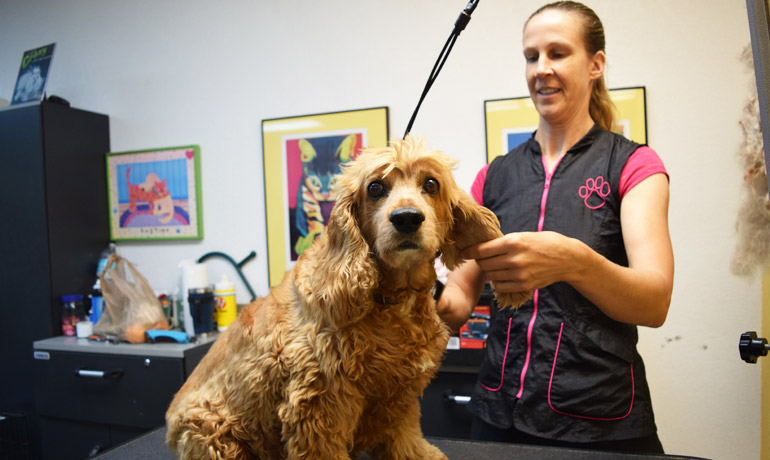Pet Care Facts & Tips
Did You Know … ? Check our great pet care facts and tips:
Pet Fur Trimming for Health!
The grooming of your pet’s fur is not solely for cosmetic reasons:
- Regular trimming in between the pads of the paws reduces the chance of fungal growth and collection of debris. In addition, your pet will get better traction and won’t slip on your tile floors!
- Neatly trimmed “private areas” stay cleaner, and therefore much healthier. A neatly trimmed anal area is less likely to have feces sticking to it. This can cause terrible irritation and irritability.
- Keeping the area surrounding the eyes neatly trimmed keeps that area cleaner and less likely to lead to infection. It also keeps the fur from going into the eyes, which can be very uncomfortable for your pet.

A Home Dental Program For Your Pet

Brushing Your Pet’s Teeth
Step 1: Introduce a brushing program to pets gradually. Avoid restraining your pet and keep brushing sessions short. A cat or small dog can be held in your lap. Praise and reassure your pet throughout the process.
Step 2: At first, dip one of your fingers into the toothpaste and rub it gently over your pet’s gums and teeth.
Make the initial sessions short and positive (approx. 2-3 minutes). Important: Please do not use toothpaste for humans, as it will upset your pet’s stomach. Use pet toothpaste only.
Step 3: Gradually introduce gauze over the finger and gently scrub the teeth in a circular motion.
Step 4: Finally, introduce a soft toothbrush designed specifically for pets. We carry both toothbrushes and toothpaste for pets.
Fleas and Ticks
If your dog or cat is constantly scratching, he or she may have fleas. If your pet only has a few, it may be very difficult to spot them. A pet with many fleas will have black and white specks on the skin. These specks are actually flea “dirt.” When exposed by parting the hair, a flea may scurry away very quickly. Fleas not only make some pets very uncomfortable, they feed on their blood. This can result in a lethargic pet. Many pets are allergic to fleas and will chew parts of themselves to the point of hair loss and blood, known as “hot spots.”
Ticks are usually stationary while they feed on your pet’s blood. They feed until gorged and then drop off to lay eggs. It is best to try to eliminate a tick problem as soon as detected because they lay an enormous amount of eggs and will infest an area quite quickly. If your pet has ticks, the Fur Crazy staff will remove them to prevent the problem from getting worse.
We recommend a veterinary examination for pets that are infested with fleas or ticks, in order to ensure your pet’s general health has not been compromised.
There are some non-toxic methods of fighting fleas and ticks. A flea comb is a very good way of removing fleas. It requires a little patience. Comb your pet after every walk, before reentering your house. Some people find diatomaceous earth effective as a “flea powder,” and Fur Crazy keeps it in stock. We also carry Nobugz for Dogs, an all-natural, spray-on insect repellent specially formulated for dogs; Ark Naturals’ Flea Flicker! Tick Kicker! — a natural, botanical alternative to chemical pesticides in controlling fleas and ticks; and Flea Flicker by Aromadog, a natural treatment to repel fleas that contains an aromatic blend of key essential oils.

Cane Toads Can Kill Your Pet!
The cane toad (Rhinella marina), also called the ”Bufo toad” or marine toad, can grow to 7 inches or more and weigh more than 3 lbs. The animal’s call sounds like a tractor in the distance. This South American invader resemble Jabba the Hutt of Star Wars, with swollen glands behind each eye that contain a milky white toxin the toad secretes when threatened.
Dogs who get too curious about these frequent lawn visitors in South Florida can suffer the consequences if they touch the toads with their tongues. The first sign of a problem is the dog starts foaming at the mouth. At this point you need to be quick and flush out the dog’s mouth with a hose if possible — crosswise, and not down the throat. If the dog seems fine and has no problems afterward you should be OK. If you see anything out of the ordinary, you need to call your vet and get your pet over there immediately. If you are not sure, please call!
These toads can also be small and still cause the same problems. If it looks like a toad, always assume it is a poisonous one — don’t take chances!
Always supervise your pet out in the yard, especially at dawn or dusk when the toads are more prevalent. Again, it is always better to be safe than sorry – check your yard before letting your pet out and always watch it.

Heatstroke Can Be Deadly!
Heatstroke occurs when your pet’s body temperature gets too high. If you leave a pet in a parked car, even with open windows, temperatures in the car can climb to lethal temperatures within minutes, especially in South Florida! Do not leave or tie a pet outside without shade on a hot day and do not exercise the animal when it is too hot.
Know the signs: Dogs dissipate heat by panting, but in some extreme weather conditions that’s not enough to adequately lower their temperature. Any of the following signs may indicate that your pet is overheated: excessive panting and drooling, vomiting and/or diarrhea, an elevated heart rate, lethargy, odd behavior, seizures or very red gums. Remember: Since dogs do not have sweat glands, they are more vulnerable to heatstroke.
Be aware that some breeds are especially vulnerable to the effects of heat (short-nosed breeds such as bulldogs or boxers, for example). Also, the smaller the dog, the faster it can overheat. This is especially true for black dogs – they absorb more heat. White dogs are also prone to sunburn. Small dogs should never be left alone in cars or placed in hot cars before cooling off the car. Also you must be careful on hot pavement: since dogs are lower to the ground, they can overheat very quickly.
